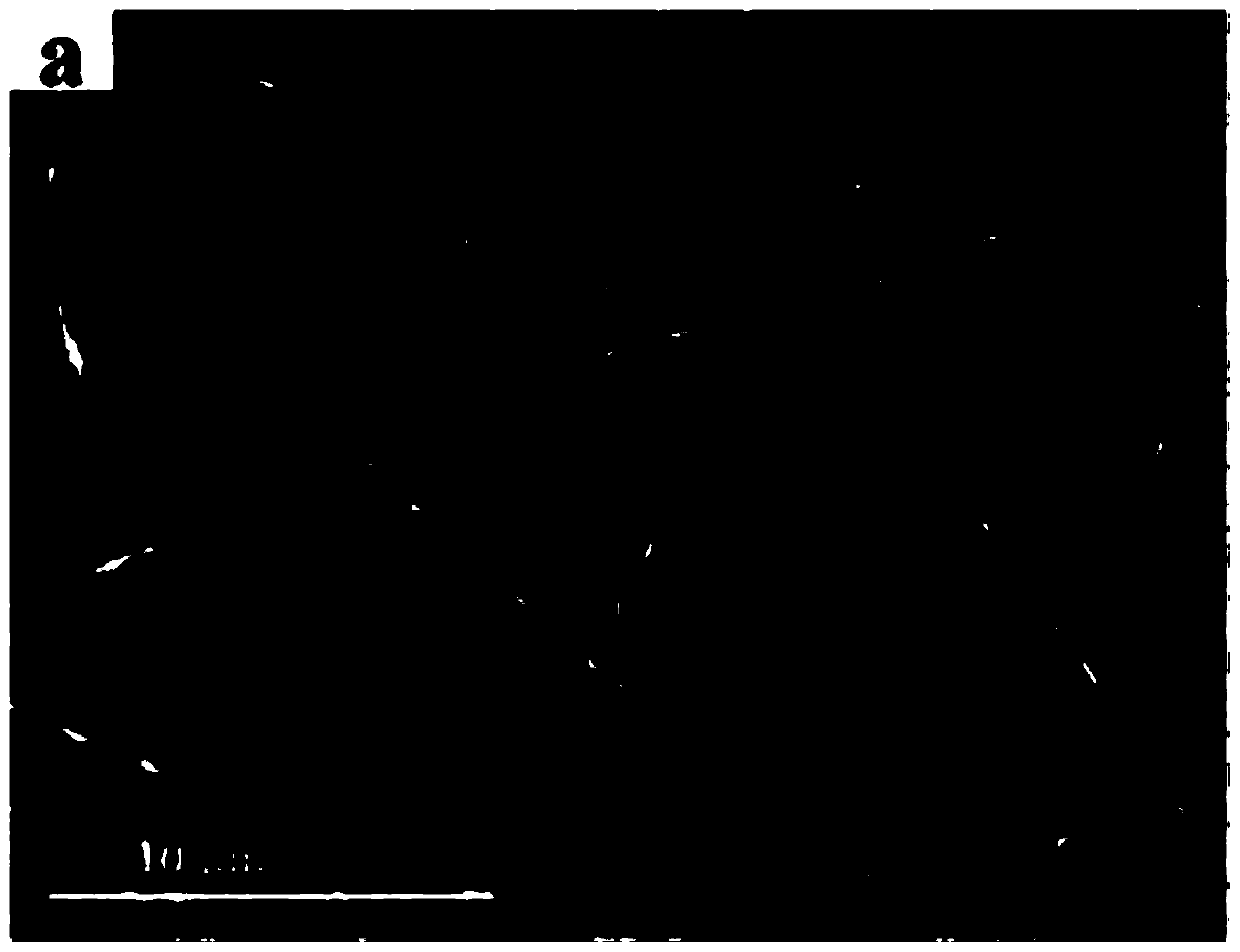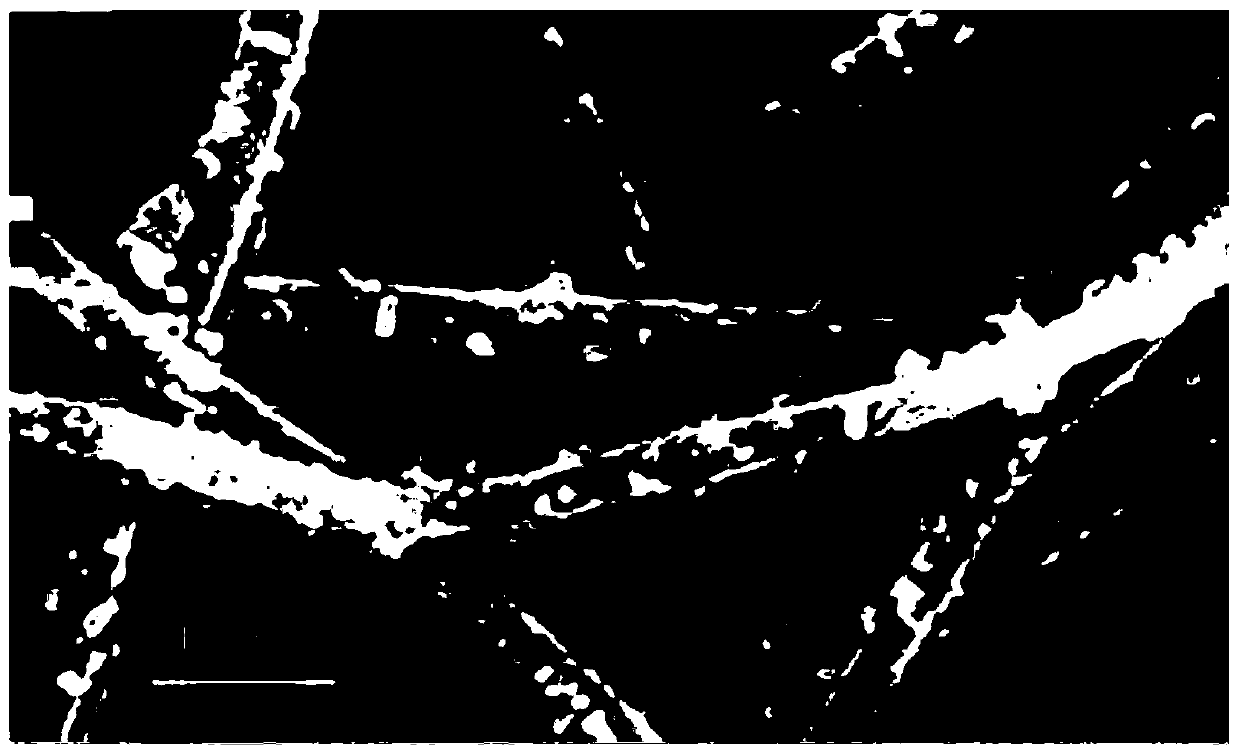Preparation method and application of metal organic framework carbon fiber composite film
A metal-organic framework and composite film technology, applied in the fields of carbon fiber, fiber processing, hybrid/electric double-layer capacitor manufacturing, etc., can solve the problems of affecting discharge capacity, large electrolyte transfer resistance, limiting rate performance, etc., and achieve good conductivity. and three-dimensional network structure, easy mass production, avoid adverse effects
- Summary
- Abstract
- Description
- Claims
- Application Information
AI Technical Summary
Problems solved by technology
Method used
Image
Examples
Embodiment 1
[0043] Step 1: dissolving polyacrylonitrile in N,N-dimethylformamide as a spinning solution, wherein the mass fraction of polyacrylonitrile in the spinning solution is 10%, stirring at 70°C for 24 hours to fully dissolve it to obtain Clear and transparent solution A.
[0044]Step 2: Then put 10mL of solution A in the syringe, spin at 10KV voltage, 25°C, and 10% relative humidity, and the distance between the needle tip of the syringe and the receiving plate is 5cm to obtain a polyacrylonitrile nanofiber membrane. The obtained polyacrylonitrile nanofiber membrane was pre-oxidized in air at 300° C. for 2 hours, then calcined in argon at 1000° C. for 2 hours to carbonize the polyacrylonitrile, and dried to obtain a CNF membrane.
[0045] Step 3: Place the CNF membrane in a mixed gas of ozone and oxygen, wherein the volume fraction of ozone is 3%, the flow rate of the mixed gas is 20mL / min, and treat at 30°C for 20min to make a functionalized CNF membrane .
[0046] Step 4: Plac...
Embodiment 2
[0048] Step 1: dissolving polyacrylonitrile in N,N-dimethylformamide as a spinning solution, wherein the mass fraction of polyacrylonitrile in the spinning solution is 20%, stirring at 70°C for 24 hours to fully dissolve it to obtain Clear and transparent solution A.
[0049] Step 2: Then put 8mL of the above solution in the syringe, and spin under the conditions of 20KV voltage, 20°C, and 20% relative humidity. The distance between the needle tip of the syringe and the receiving plate is 10cm to obtain a polyacrylonitrile nanofiber membrane. The obtained polyacrylonitrile nanofiber membrane was pre-oxidized in air at 300° C. for 3 h, then calcined at 900° C. for 2 h in nitrogen to carbonize the polyacrylonitrile, and dried to obtain a CNF membrane.
[0050] Step 3: Place the CNF membrane in a mixed gas of ozone and oxygen, wherein the volume fraction of ozone is 7%, the flow rate of the mixed gas is 10mL / min, and treat at 20°C for 40min to make a functionalized CNF membrane ...
Embodiment 3
[0053] Step 1: Dissolve polylactic acid in N,N-dimethylformamide as a spinning solution, wherein the mass fraction of polylactic acid in the spinning solution is 5%, stir at 40°C for 30 hours to fully dissolve to obtain clarity solution A.
[0054] Step 2: Then place 3mL of the above solution in a syringe, spin at 30KV voltage, 10°C, and 40% relative humidity, and the distance between the needle tip of the syringe and the receiving plate is 10cm to obtain a polylactic acid nanofiber membrane. The obtained polylactic acid nanofiber membrane was pre-oxidized in air at 200° C. for 1 h, then calcined in argon at 800° C. for 3 h to carbonize the polylactic acid, and dried to obtain a CNF membrane.
[0055] Step 3: Place the CNF membrane in a mixed gas of ozone and oxygen, wherein the volume fraction of ozone is 1%, the flow rate of the mixed gas is 50mL / min, and treat at 60°C for 10min to make a functionalized CNF membrane .
[0056] Step 4: Place the functionalized CNF membrane ...
PUM
 Login to View More
Login to View More Abstract
Description
Claims
Application Information
 Login to View More
Login to View More - R&D
- Intellectual Property
- Life Sciences
- Materials
- Tech Scout
- Unparalleled Data Quality
- Higher Quality Content
- 60% Fewer Hallucinations
Browse by: Latest US Patents, China's latest patents, Technical Efficacy Thesaurus, Application Domain, Technology Topic, Popular Technical Reports.
© 2025 PatSnap. All rights reserved.Legal|Privacy policy|Modern Slavery Act Transparency Statement|Sitemap|About US| Contact US: help@patsnap.com



